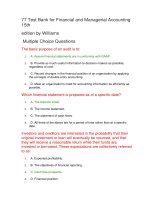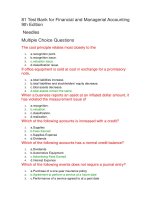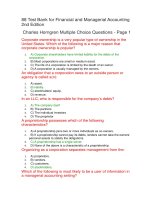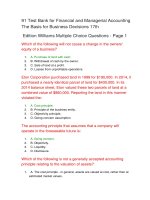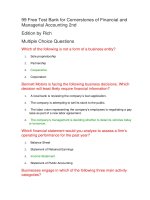Financial and managerial accounting 2nd kimel kieso willey chapter 21
Bạn đang xem bản rút gọn của tài liệu. Xem và tải ngay bản đầy đủ của tài liệu tại đây (2.54 MB, 50 trang )
21-1
21
Incremental Analysis
Learning Objectives
21-2
1
Describe management’s decision-making process and
incremental analysis.
2
Analyze the relevant costs in accepting an order at a special
price.
3
Analyze the relevant costs in a make-or-buy decision.
4
Analyze the relevant costs in determining whether to sell or
process materials further.
5
Analyze the relevant costs to be considered in repairing,
retaining, or replacing equipment.
6
Analyze the relevant costs in deciding whether to eliminate an
unprofitable segment or product.
LEARNING
OBJECTIVE
1
Describe management’s decision-making
process and incremental analysis.
Making decisions is an important management function.
Does not always follow a set pattern.
Decisions vary in scope, urgency, and importance.
Steps usually involved in process include:
Illustration 21-1
Management’s decision-making process
21-3
LO 1
Decision-Making Process
In making business decisions,
Considers both financial and non-financial information.
Financial information
21-4
►
Revenues and costs, and
►
Effect on overall profitability.
Nonfinancial information
►
Effect on employee turnover
►
The environment
►
Overall company image.
LO 1
Incremental Analysis Approach
21-5
Decisions involve a choice among alternative actions.
Process used to identify the financial data that change
under alternative courses of action.
►
Both costs and revenues may vary or
►
Only revenues may vary or
►
Only costs may vary
LO 1
How Incremental Analysis Works
Illustration 21-2
Basic approach in incremental analysis
Incremental
revenue is $15,000 less under Alternative B.
Incremental
cost savings of $20,000 is realized.
Alternative
21-6
B produces $5,000 more net income.
LO 1
How Incremental Analysis Works
Important concepts used in incremental analysis:
21-7
Relevant cost.
Opportunity cost.
Sunk cost.
LO 1
How Incremental Analysis Works
21-8
Sometimes involves changes that seem contrary to
intuition.
Variable costs sometimes do not change under
alternatives.
Fixed costs sometimes change between alternatives.
LO 1
Service Company Insight
American Express
That Letter from AmEx Might Not Be a Bill
No doubt every one of you has received an invitation from a
credit card company to open a new account—some of you have
probably received three in one day. But how many of you have
received an offer of $300 to close out your credit card account?
American Express decided to offer some of its customers $300 if
they would give back their credit card. You could receive the $300
even if you hadn’t paid off your balance yet, as long as you
agreed to give up your credit card.
Source: Aparajita Saha-Bubna and Lauren Pollock, “AmEx Offers Some
Holders $300 to Pay and Leave,” Wall Street Journal Online (February
23, 2009).
21-9
LO 1
Types of Incremental Analysis
Common types of decisions involving incremental analysis:
1. Accept an order at a special price.
2. Make or buy component parts or finished products.
3. Sell or process further them further.
4. Repair, retain, or replace equipment.
5. Eliminate an unprofitable business segment or product.
21-10
LO 1
Incremental Analysis
Question
Incremental analysis is the process of identifying the financial
data that
21-11
a.
Do not change under alternative courses of action.
b.
Change under alternative courses of action.
c.
Are mixed under alternative courses of action.
d.
None of the above.
LO 1
1
Incremental Analysis
Owen T Corporation is comparing two different options. The
company currently follows Option 1, with revenues of $80,000 per
year, maintenance expenses of $5,000 per year, and operating
expenses of $38,000 per year. Option 2 provides revenues of
$80,000 per year, maintenance expenses of $12,000 per year, and
operating expenses of $32,000 per year. Option 1 employs a piece
of equipment that was upgraded 2 years ago at a cost of $22,000. If
Option 2 is chosen, it will free up resources that will increase
revenues by $3,000.
Complete the following table to show the change in income from
choosing Option 2 versus Option 1. Designate any sunk costs with
an “S.”
21-12
LO 1
The company currently follows Option 1, with revenues of $80,000
per year, maintenance expenses of $5,000 per year, and operating
expenses of $38,000 per year. Option 2 provides revenues of
$80,000 per year, maintenance expenses of $12,000 per year, and
operating expenses of $32,000 per year. Option 1 employs a piece
of equipment that was upgraded 2 years ago at a cost of $22,000. If
Option 2 is chosen, it will free up resources that will increase
revenues by $3,000.
21-13
LO 1
LEARNING
OBJECTIVE
2
Analyze the relevant costs in accepting an
order at a special price.
Accept an Order at a Special Price
21-14
Obtain additional business by making a major price
concession to a specific customer.
Assumes that sales of products in other markets are
not affected by special order.
Assumes that company is not operating at full capacity.
LO 2
Accept an Order at a Special Price
Illustration: Sunbelt Company produces 100,000 Smoothie
blenders per month, which is 80% of plant capacity. Variable
manufacturing costs are $8 per unit. Fixed manufacturing costs are
$400,000, or $4 per unit. The blenders are normally sold directly to
retailers at $20 each. Sunbelt has an offer from Kensington Co. (a
foreign wholesaler) to purchase an additional 2,000 blenders at
$11 per unit. Acceptance of the offer would not affect normal sales
of the product, and the additional units can be manufactured
without increasing plant capacity. What should management do?
21-15
LO 2
Accept an Order at a Special Price
Illustration 21-4
Incremental analysis—accepting
an order at a special price
Fixed costs do not change since within existing capacity – thus
fixed costs are not relevant.
Variable manufacturing costs and expected revenues change –
thus both are relevant to the decision.
21-16
LO 2
2
Special Orders
Cobb Company incurs costs of $28 per unit ($18 variable and $10
fixed) to make a product that normally sells for $42. A foreign
wholesaler offers to buy 5,000 units at $25 each. Cobb will incur
additional shipping costs of $1 per unit. Compute the increase or
decrease in net income Cobb will realize by accepting the special
order, assuming Cobb has excess operating capacity. Should Cobb
Company accept the special order?
Accept
or
Reject?
21-17
LO 2
LEARNING
OBJECTIVE
3
Analyze the relevant costs in a make-orbuy decision.
Illustration: Baron Company incurs the following annual costs in
producing 25,000 ignition switches for motor scooters.
Illustration 21-5
Annual product
cost data
Instead of making its own switches, Baron Company might purchase
the ignition switches at a price of $8 per unit. “What should
management do?”
21-18
LO 3
Make or Buy Decision
Illustration 21-6
Incremental analysis
—make or buy
Total manufacturing cost is $1 higher per unit than purchase price.
Must absorb at least $50,000 of fixed costs under either option.
21-19
LO 3
Opportunity Cost
The potential benefit that
may be obtained from
following an alternative
course of action.
21-20
LO 3
Opportunity Cost
Illustration: Assume that through buying the switches, Baron
Company can use the released productive capacity to generate
additional income of $38,000 from producing a different product.
This lost income is an additional cost of continuing to make the
switches in the make-or-buy decision.
21-21
Illustration 21-7
Incremental analysis—make or
buy, with opportunity cost
LO 3
Make or Buy Decision
Question
In a make-or-buy decision, relevant costs are:
21-22
a.
Manufacturing costs that will be saved.
b.
The purchase price of the units.
c.
Opportunity costs.
d.
All of the above.
LO 3
Service Company Insight
Amazon.com
Giving Away the Store?
In an earlier chapter, we discussed Amazon.com’s incredible growth. However,
some analysts have questioned whether some of the methods that Amazon
uses to increase its sales make good business sense. For example, a few years
ago, Amazon initiated a “Prime” free-shipping subscription program. For a $79
fee per year, Amazon’s customers get free shipping on as many goods as they
want to buy. At the time, CEO Jeff Bezos promised that the program would be
costly in the short-term but benefit the company in the long-term. Six years later,
it was true that Amazon’s sales had grown considerably. It was also estimated
that its Prime customers buy two to three times as much as non-Prime
customers. But, its shipping costs rose from 2.8% of sales to 4% of sales, which
is remarkably similar to the drop in its gross margin from 24% to 22.3%.
Perhaps even less easy to justify is a proposal by Mr. Bezos to start providing a
free Internet movie-streaming service to Amazon’s Prime customers. Perhaps
some incremental analysis is in order?
Source: Martin Peers, “Amazon’s Prime Numbers,” Wall Street Journal Online (February
3, 2011).
LO 1
21-23
3
Make or Buy
Juanita Company must decide whether to make or buy some of its
components for the appliances it produces. The costs of producing
166,000 electrical cords for its appliances are as follows.
Direct materials
Variable overhead
$90,000
$32,000
Direct labor
Fixed overhead
20,000
24,000
Instead of making the electrical cords at an average cost per unit of
$1.00 ($166,000 ÷ 166,000), the company has an opportunity to buy the
cords at $0.90 per unit. If the company purchases the cords, all variable
costs and one-fourth of the fixed costs will be eliminated.
(a) Prepare an incremental analysis showing whether the company
should make or buy the electrical cords. (b) Will your answer be different
LO 3
21-24 if the released productive capacity will generate additional income of
3
(a)
Make or Buy
Prepare an incremental analysis
showing whether the company should make or buy the electrical
cords.
Juanita Company will incur $1,400 of additional costs if it buys the
electrical cords rather than making them.
21-25
LO 3



